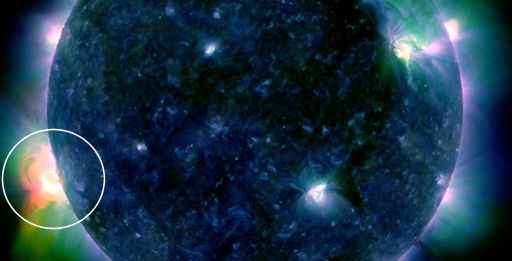ICONIC ERUPTION: A huge filament of magnetism and hot plasma blasted off the sun's southwestern limb on March 19th around 1200 UT. NASA's Solar Dynamics Observatory recorded the action:
The eruption was not Earth-directed, but it did attract plenty of attention on our planet. Many amateur astronomers in Europe witnessed the blast and said it was the biggest one they'd ever seen. This event continues the recent trend of increasing solar activity, and shows anew that Solar Cycle 24 is gaining steam after a long period of relative quiet.
source
There appears to be a direct correlation between solar flares and earthquakes. As the Moon affects our tides, the Sun appears to affect the mantle, tectonic plates and disrupts electrical activity. When there are large solar flares, within a short period of time we experience earthquakes here on Earth. However it is believed that there must be certain conditions upon the Earth in order for the affect to be significant.
Read more
A Doubling of the Sun's Coronal Magnetic Field during the Last 100 Years
UPDATE: March 10th 2011
Earth's magnetic field is still reverberating from a CME strike on March 10, 2011 which resulted in a G1-class geomagnetic storm. Northern Lights have rippling over the US-Canadian border into states such as Wisconsin, Minnesota, and Michigan. Solar wind conditions favour more geomagnetic storming in the hours ahead. Sky watchers, including those in the continental United States, should remain alert for auroras.
03.10.11 - Another X-Class Solar Flare and a CME
 › Download
› DownloadCredit: NASA/SDO
March 9th ended with a powerful solar flare. Earth-orbiting satellites detected an X1.5-class explosion from behemoth sunspot 1166 around 2323 UT. A movie from NASA's Solar Dynamics Observatory (above) shows a bright flash of UV radiation plus some material being hurled away from the blast site.
Coronagraph data from the Solar and Heliospheric Observatory show no bright coronal mass ejection (CME) emerging from this eruption. Some material was surely hurled in our direction, but probably not enough for significant Earth-effects. Updates will be provided as more information becomes available.
In addition, on March 10, 2011 around 0630 UT, a CME did strike a glaceing blow to Earth's magnetic field. This was a result of an M3 flare that occurred late on March 7, 2011. At 2,200 km/sec, this was the fasted CME since September 2005. Below is an impact image provided from a sky watcher in Canada. Visit www.spaceweather.com for links to more great aurora imagery.
 › Download
› DownloadThis aurora image was taken just west of Edmonton, Alberta, Canada by a sky watcher. Credit: Zoltan Kenwell
- What is going on with all this recent solar activity?
- What is a solar flare and what does X-class mean?
Scientists classify solar flares according to their brightness in the x-ray wavelengths. There are three categories: C, M, X, with each one representing approximately 10x more power. The number following the letter indicates another factor applied to the basic classification scheme, from 1-9. At the high end, the X class can go higher than 9 because there is no higher letter classification.
- What is a coronal mass ejection (CME)?
Tony Phillips/Holly Zell
NASA's Goddard Space Flight Center
source
Japanese media reported at least 18000 people are presumed dead from Friday's massive 8.9 earthquake, most drowned by Tsunami that swept across the northeast coast of the island nation.Read more
And its not only a coincidence that it happened exactly after 24 hours Solar flare hit Earth.
UPDATE: March 21st 2011
Coronal Holes: 21 Mar 11A solar wind stream flowing from this minor coronal hole could reach Earth on March 23rd or 24th. Credit: SDO/AIA.
Enlarged image below
HERE COMES TROUBLE? Updated: 22/03/11
A big sunspot is emerging over the sun's southeastern limb, and it is crackling with activity. NASA's Solar Dynamics Observatory recorded a surge of extreme ultraviolet radiation from the sunspot's magnetic canopy on March 21st:
This appears to be the return of old sunspot 1165, last seen in early March when it formed on the sun's southwestern limb. Since then it has been transiting the far side of the sun, apparently growing in size and restlessness. The potential for trouble will become more clear in the hours ahead as the active region emerges in full. Stay tuned.
Then and Now






No comments:
Post a Comment